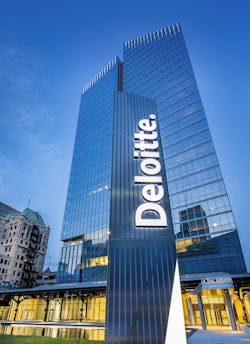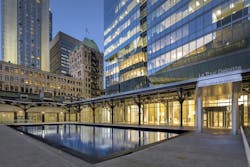The Deloitte Tower
The Cadillac Fairview Corporation Limited, along with its major tenant Deloitte, helped create the first, new, privately-owned and financed commercial office tower in more than 20 years to be built in the city of Montreal, Quebec. The tower is located in the vibrant Quad Windsor neighborhood next to the heritage-designated Windsor Station entertainment venue and connects directly to the Bell Centre, home of the Montreal Canadiens professional hockey team. This 560,000-square foot project provides premium office space and approximately 230 parking spots in an active and very visible part of downtown Montreal. The spirit of the city is seen as alive and strong in this setting, despite its cold climate.
The challenge:
aggresive green building performance
Cadillac Fairview initiated a nationwide effort known as Green at Work, which tracks energy consumption, water usage and waste diversion in developments that the company manages across Canada with the goal of progressive improvement each and every year. For the Deloitte Tower, the decision was made to target a LEED® Platinum CS certification for the Core and Shell of the building. Tenants, including Deloitte, are subsequently requested to pursue LEED® CI for Commercial Interiors at the gold or platinum level. The challenge includes allowing plenty of natural daylight to reduce electric light usage while still efficiently keeping heat gain and loss under control. The intent is to realize energy cost savings of 35-40% and reduced greenhouse gas emissions from lower power consumption. The Canadian Green Building Council (CaGBC) oversees the Leadership in Energy and Environmental Design (LEED) program in Canada. Additional certification goals include sustainable site work, water conservation, indoor air quality, and sustainable use of materials and resources.
The design solution:
abundant daylight and views
Early in the planning phase, the architectural teams collaborated with glass and curtain wall fabricators to ensure the best possible selection of suitable products to optimize the energy efficiency and visual appeal of the building. They ultimately settled on a curtain wall design using lightly tinted grey vision glass to allow abundant daylight to enter virtually the full width and over 80% of the height of the perimeter walls on all of the office floors, which also affords spectacular vistas of the city. Grey tinted windows offer a more reflective look from the outside of the building, while providing occupants of the building with a greater sense of transparency in the glass than darker tinted windows. Based on these characteristics, Guardian Industries glass, color AG50 crystal grey, was specified by the architects for the glazing.
In order to control heat gain and loss, the glazing in the project is made up of dual pane insulating glass units (IGUs) with a low emissivity (low- E) grey colored coating on the inside surfaces. The glass supplier and fabricator of the IGUs was Multiver Ltée of Quebec. Throughout the planning and design process, they assisted the architects with performance calculations, color selection, and other support. They recognized that the total performance of the glazing would be influenced not only by the glass itself but by the spacer that held the dual panes together. Numerous independent tests and certification organizations have confirmed that selecting an inferior IGU spacer results in the edges, as well as the center of the glass, performing poorly in terms of heat transfer. If the seal along the edge of the spacer does not hold up, then air and water vapor can seep into the glass space otherwise filled with an inert gas. When that happens, the glass appears streaked or stained on the inside and performs even worse. Further, in cold climates like Montreal, condensation can form on the inside of the glass along the cold edges causing other problems for the building components nearby. Together, the architects and Multiver chose plastic hybrid stainless steel (PHSS) spacers manufactured by Technoform. They met their design criteria for both excellent energy efficiency and the ability to meet unique aesthetic requirements.
Specifically, they selected a 17/32” (13.44mm) spacer in light grey to match the glass color beautifully.
"Our prebuild simulations clearly indicated that Technoform’s spacer offered superior U-factor, vapor barrier, site-line temperature and condensation resistance - exactly the right combination of quality, value and appearance for the tower project. We simply could not achieve this any other way."
- Luc Cormier, Vice president of operations, Multiver Ltée
Epsylon Concepts, Ltd. of Quebec designed, engineered, manufactured, and installed the curtain wall system. They also conduct an evaluation of all their products in regard to LEED certification for materials and vetted all products for compliance with the LBC “Red List” of 14 potentially toxic substances.
Because of the size and expanse of the curtain wall system, a pre- fabricated, unitized system was determined the best choice. Generally, these systems are used on mid-rise to high-rise structures that are 20,000 square feet and up where there is high repetition, tight job site access, and high installation labor costs. These systems hold up over time better than others because each curtain wall panel is installed to be able to expand and contract independently from the supporting structure and retain its ability to be completely weather tight.
The design team selected a structural silicone curtain wall system. Compared to traditional curtain wall systems that use continuously gasketed aluminum pressure plates or caps that can conduct large amounts of heat in or out of the façade resulting in “thermal bridging,” structurally glazed curtain wall systems consist of glass that is
bonded or anchored back to a frame with engineered silicone sealant that can reduce or eliminate the thermal bridging along the joints between adjacent IGUs. The aesthetic benefit of a structural silicone glazed system is the creation of greater transparency than traditional systems. There are less visual interruptions due to the lack of metal on the exterior, creating a seamless, continuous glass look. This system creates a completely clean, flush exterior appearance with superior energy performance. Precision is needed in sealing the units together since there is no outside metal frame to cover any irregularities or imperfections.
That goes for the glass spacers used too, since in some cases they can be left partly exposed and create an unintended visual appearance. Technoform’s spacer used in this project extends the colored polypropylene through an extended sidewall ensuring minimal opportunity for stainless steel peek through and overcoming this common quality control issue on structural silicone glazed units.
After the IGUs and spandrel glass are glazed into unit frames within the shop, they are transported and installed at the job site by crane. The installed units then receive additional silicone and or EPDM gaskets on the exterior creating “stack joints” as the complete air and moisture barrier of the system allowing a weep at each floor.
The result:
high design and high performance
The Deloitte Tower is a stunning example of design and functionality coming together beautifully by paying attention to the details of the glazing system. The collaborative effort of the owner, design team, fabricators, and installers created an environment that eliminates visual barriers offering a desirable and productive office setting. All in all, with the goal of LEED Platinum, the Deloitte Tower will certainly be a jewel for the downtown Montreal area.
Project: Deloitte Tower
Location: Montreal, Quebec, Canada
Owner/Developer: Cadillac Fairview Corporation, Limited
Architects: Kohn Pedersen Fox (KPF) with Bregman & Hamann (B+H)
Curtain wall fabricator: Epsylon Concepts, Ltd.
Glass fabricator: Multiver Ltée
Product: Technoform’s PHSS warm edge spacer
1755 Enterprise Parkway, Twinsburg, Ohio 44087
330-487-6600
Technoform.com
©2021 Technoform MTKE-10 10.22.2021


